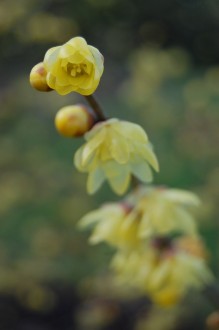Position: Full sun to dappled shade
Flowering period: Winter
Soil: Moist, well drained
Eventual Height: 5m
Eventual Spread: 3m
Hardiness: 6a, 6b, 7a, 7b, 8a, 8b, 9a, 9b
Family: Calycanthaceae
Chimonanthus praecox is a vigorous deciduous, bushy medium sized shrub. Its glossy dark green leaves are lanceolate, up to 20cm long and 10cm broad. Its waxy, hermaphrodite, yellow flowers have purple stained centres, are cup shaped, pendant, up to 3cm across, with spirally arranged tepals, are strongly scented and appear on bare branches. Its brown fruit is an elliptic capsule and up to 2.5cm in length.
Chimonanthus praecox, commonly known as Wintersweet or Japanese Allspice, is native to China.In its native habitat it grows in mountain forests. Chimonanthus praecox is synonymous with Chimonanthus fragrans. It was introduced into European gardens from Japan and was noted in England 1766 when it was grown under glass for the Sixth Earl of Coventry in the conservatory at Croome Court, Worcestershire.
The etymological root of the binomial name Chimonanthus is derived from the Greek xeimwn ‘winter’ and anqos ’flower’. Praecox is derived from the Latin prae meaning ‘before’ and coxi meaning ‘ripening’, i.e. early ripening.
The landscape architect may find Chimonanthus praecox useful as a low maintenance, winter flowering, fragrant shrub.
Ecologically, Chimonanthus praecox is attractive to pollinating insects and beetles.
Chimonanthus praecox prefers moist, fertile, well-drained soils. It tolerates most pH of soil. It will not tolerate winter water logging.
Chimonanthus praecox requires little maintenance. Pruning should be carried out in early spring, after flowering.










